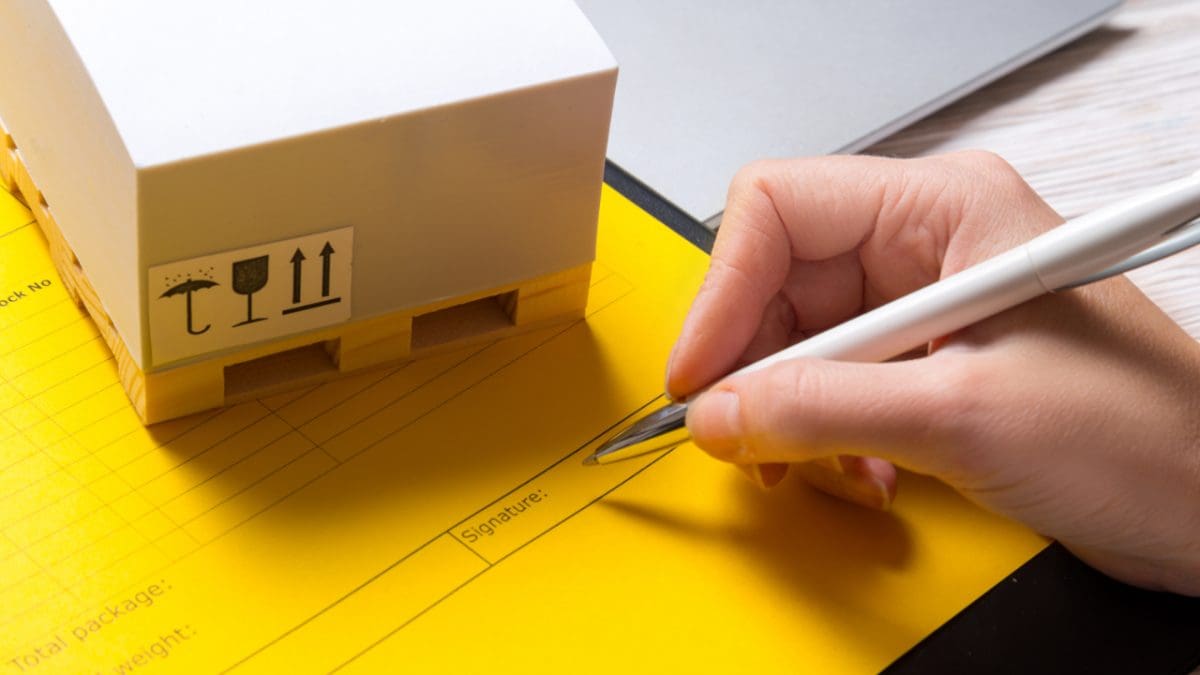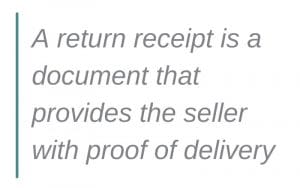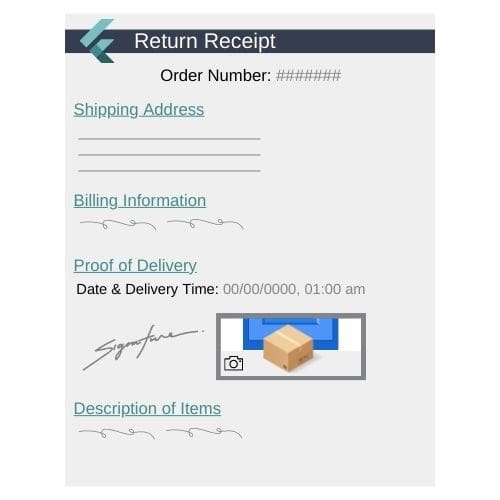
Today’s transportation and logistics industry leverages technology to meet the increased demand for flexible, traceable, fast, and personalized last mile delivery logistics. Despite this rapid growth, many eCommerce businesses still rely heavily on paper documents like the ‘Return Receipt’ to process and approve the shipping and return of merchandise.
Most online retailers manually print out these documents before keying them into another electrical system. Unfortunately, this approach translates to human errors, information delays, and hours of redundant labor, increasing the need for automation and optimized returns processes. Similarly, many businesses underestimate the importance of delivery return receipts.
In this article, we discuss what to include in a last mile return receipt and why it’s important for your business.
What is a Return Receipt?

A return receipt is a document that provides the seller (your business) with proof of delivery (POD). Once you process a customer’s return and approve a refund by product exchange, you’re required to ship another merchandise back to your consumer. This part of the returns process is known as last mile delivery.
A return receipt confirms that your customer received their product exchange. In most cases, delivery persons and drivers are responsible for capturing POD and confirming the successful delivery of a customer’s return. They can do this by:
- Paper: The customer signs a return receipt form. They get to keep one copy while the driver keeps another copy for the business.
- Photo: If the customer isn’t home, the driver can capture POD by taking a picture showing where they left the product exchange, the time of delivery, and the delivery address.
- Digital Signature: The customer signs a digital return receipt form on a mobile device. They get a copy of the receipt via email, and you also automatically get a signed copy too.
Last-mile delivery, which involves the transportation of goods from a distribution center or logistics hub to the consumer’s doorstep, has always been the most difficult step of the entire shipping process. According to research, it’s the least efficient aspect of the supply chain, accounting for 53% of overall logistics expenses. Unfortunately, POD documents such as receipts are a key factor in last mile inefficiencies, but they’re vital to your supply chain.
Importance of Return Receipts
Here’s why return receipts are beneficial to customers and businesses:
1. Keeps the Logistics Channel Updated
Return receipts keep your logistics chain updated, improving control and traceability. Once the delivery person gets POD or the receiver’s signature, your system automatically updates to show the item was delivered. This way, there’s less confusion about delivery status and less follow-up on where a return is in the supply chain.
For online retailers, automating the returns process is crucial to avoid manually tracking product exchanges. With a digital channel, your entire logistics channel, from the business to the reverse logistics company to the customer, stays updated using the return receipt. This makes your returns process fast, efficient, and reliable. Remember, 80% of consumers want speed, convenience, and friendly delivery services. Making your returns process automatic goes a long way in ensuring it meets these qualities.
2. Right Person, Right Delivery Concept
Return receipts are vital in ensuring the correct delivery of items to the right person. Since the receipt contains relevant information about the product and the delivery address, the driver and customer can cross-check the consignment with the receipt details. As a result, there are fewer logistics errors, saving your business time and money.
3. Minimizes Return Abuse
Return fraud and abuse cost eCommerce retailers millions of dollars every year. Research shows online retailers lose up to 3% of their annual revenue to return fraud. This increases the need for measures to minimize fraud on friendly return policies, such as proof of delivery documents.
It’s pretty common for people to request refunds for products not delivered when they were actually delivered, which costs businesses a lot of revenue. With POD documents, customers acknowledge receiving a product delivered to them. As a result, they can’t file claims stating the retailer never delivered the product.
Even if the receiver is not around to sign the receipt, the delivery person can take pictures showing where they left the items, the delivery time, and the delivery address. Such evidence makes it impossible for fraudsters to claim refunds for products they never received.
4. Completes the Delivery Process
A return receipt signifies the end of the delivery process. It provides proof the item was delivered and that the customer received it by signing the POD documents. It also acknowledges that the delivered item is as described, undamaged, and in good condition. This ensures customer satisfaction while allowing your business to complete a refund by product exchange delivery.
What To Include On Your Returns Receipt
Here are seven items you should include in your return receipt:
1. Order Number
The order number is an essential reference number that your business uses to track the product exchange. It’s also known as a tracking number and it ensures you can quickly identify an order in case something goes wrong. With the tracking number, your customer can keep track of the delivery of their product exchange.
2. Seller Information
The seller information comprises your company name, telephone number, business address, and any other essential contact information. This information shows your customer where the product exchange has come from, so they can easily reach out to you for inquiries and further assistance.
3. Shipping Address

The shipping address comprises your customer’s delivery address, street address, city, state, zip, and contact information. Including a shipping address ensures your reverse logistics partner knows where to deliver the product exchange to. This way, the products are shipped to the correct address. Including a shipping address can also help identify delivery problems, like delivering an order to the wrong address.
4. Billing Information
Billing information shows proof of who paid for the product exchange and the total amount paid. In today’s shopping landscape, customers expect eCommerce retailers to provide free returns, with 87% stating free returns play an important role in their purchasing decision. So, if you offer free returns, your billing details should include your name and address. If you don’t, include a delivery charge in the billing information.
5. Description of Item(s) Delivered
Be sure to include a detailed description of the product exchange. This information ensures your customer receives the product as described and can confirm the contents of the shipment. It can also be useful if something is missing from the delivery or when the product doesn’t match the description.
6. Date and Time of Delivery
This is important for capturing proof of delivery. The delivery person can fill this in at the time of delivery while getting a signature from the customer or taking a photo of the delivered items. If you have digital electronic return receipts, your system will automatically record the time and date of delivery when the courier provides proof of delivery.
7. Proof of Delivery
As mentioned earlier, this could be an e-signature, a photo captured by the delivery person, or the recipient’s signature on paper. Scanning barcodes and QR codes also capture proof of delivery. The delivery person simply scans the code on the shipment, and the system automatically updates the delivery receipt. Proof of delivery is essential to confirm that the product exchange has been delivered and completed.
How To Distribute/Where To File Your Returns Receipt
When it comes to distributing delivery return receipts, the best practice is to invest in digital or electronic receipts. The traditional, paper-based proof of delivery has numerous limitations, including:
- Relying on manual processes that increase the likelihood of errors such as illegible handwriting, lost documents, and mistakes.
- Involving redundant, time-consuming tasks that reduce driver efficiency and slow your supply chain.
- Limiting accurate, real-time communication with your customers.
- It increases the cost of your returns due to all the physical resources, such as printers and papers, required to manage hard-copy receipts.
The proof of delivery concept is nothing new and dates back to the 1800s. However, the value of PODs today goes far beyond collecting signatures. Consumers want a positive delivery experience for returns that’s simple and hassle-free.
Electronic/digital delivery return receipts, which are an essential element in last mile tracking, help bridge this gap. They automate the proof of delivery process, making it more efficient for both you and your customers. Digital delivery return receipts also ensure the condition of the item is in line with the consumer’s expectations while streamlining the delivery process and protecting your business from dispute claims.
With a digital returns receipt, your customer signs for the item digitally, and both of you automatically get a copy of the proof of delivery in real-time. You can find it on your returns management dashboard while your customer receives it via email or SMS. This increases transparency and order fulfillment in every delivery.
Some of the benefits of using digital return receipts are:
- It enhances the delivery experience
- It eliminates the need for manual processes and paperwork
- It improves operational and driver efficiency
- It enhances communication with automated updates and notifications
Best Practices For Return Receipts
Here are some best practices when distributing return receipts:
- Automate your return receipts to make the process efficient and seamless.
- Ensure your customers automatically get a copy of the proof of delivery once it’s signed.
- Let a third-party reverse logistics partner like Returns Automation handle your returns automation.
- Ensure your delivery return receipts includes all the vital information, including delivery address, order number, and description of items.

FAQs
1. Which Businesses Need to Issue Delivery Return Receipts?
Any eCommerce business that issues refunds by product exchanges needs to issue delivery return receipts. This way, they can prove the delivery of products to customers while keeping the logistics channel updated. Delivery return receipts provide end-to-end accountability between you and your customers.
2. Can I Issue Delivery Receipts Online?
Yes, you can. With digital delivery return receipts, you can automatically send a copy of proof of delivery to your consumer and keep a copy for the business. To generate a delivery receipt online, you have to use a returns automation app or system that allows your delivery person to capture proof of delivery through an e-signature, QR code, or photo. Once the delivery person updates this, as well as the time and date of delivery, you automatically get a copy for the receipt.
3. Who Is Responsible For Proof of Delivery?
Business owners and delivery persons are responsible for proof of delivery. The business creates the delivery return receipt, while the delivery person is responsible for getting the customer to sign it.
4. Why Do Delivery Drivers Take Pictures of Shipments?
If a customer isn’t around to sign for a return delivery, the driver can provide proof by taking pictures of the shipment, the delivery address, and where they left the item. These pictures serve as evidence that the product was delivered to the receiver’s address.
5. What Is An Electronic Delivery Return Receipt?
An electronic return receipt is a digital version of the standard POD paper document. It uses software to confirm a package has been successfully delivered to its destination. This can be through barcodes, QR codes, e-signatures, timestamps, and photographs.
Bottom Line
Delivery return receipts are crucial for online retailers that want to improve their returns process, enhance visibility and traceability, and improve the delivery experience. At Elite EXTRA, we understand the importance of automation in today’s digital logistics landscape, and this is why we provide efficient returns management software that automates and simplifies your returns.
This software includes a proof of delivery system that instantly confirms deliveries. Once a driver arrives at the delivery location, they use a handheld device to scan the barcode on the shipment, which automatically fills the delivery return receipt with the relevant information. This includes the customer’s name and address, the date and time of delivery, and the seller’s information.
If you want to optimize and streamline your returns process, our management software is the best solution. Contact us today to request a demo!
Sources
https://www.forbes.com/
https://www.insiderintelligence.com/
https://www.pwc.com/
https://sps.honeywell.com/







